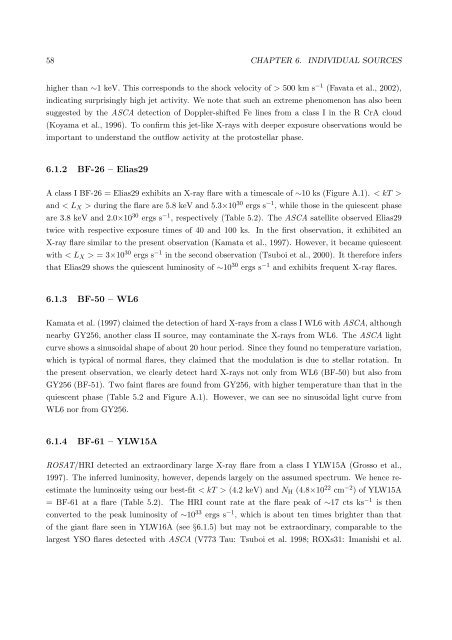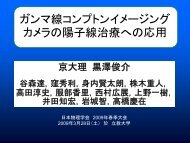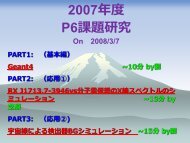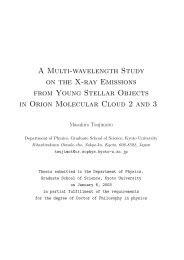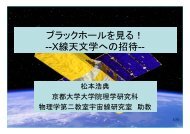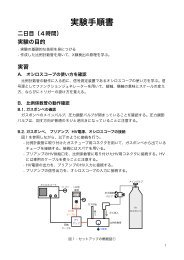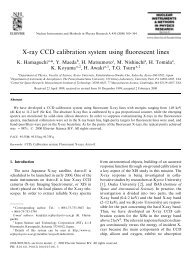X-ray Study of Low-mass Young Stellar Objects in the ρ Ophiuchi ...
X-ray Study of Low-mass Young Stellar Objects in the ρ Ophiuchi ...
X-ray Study of Low-mass Young Stellar Objects in the ρ Ophiuchi ...
You also want an ePaper? Increase the reach of your titles
YUMPU automatically turns print PDFs into web optimized ePapers that Google loves.
58 CHAPTER 6. INDIVIDUAL SOURCEShigher than ∼1 keV. This corresponds to <strong>the</strong> shock velocity <strong>of</strong> > 500 km s −1 (Favata et al., 2002),<strong>in</strong>dicat<strong>in</strong>g surpris<strong>in</strong>gly high jet activity. We note that such an extreme phenomenon has also beensuggested by <strong>the</strong> ASCA detection <strong>of</strong> Doppler-shifted Fe l<strong>in</strong>es from a class I <strong>in</strong> <strong>the</strong> R CrA cloud(Koyama et al., 1996). To confirm this jet-like X-<strong>ray</strong>s with deeper exposure observations would beimportant to understand <strong>the</strong> outflow activity at <strong>the</strong> protostellar phase.6.1.2 BF-26 – Elias29A class I BF-26 = Elias29 exhibits an X-<strong>ray</strong> flare with a timescale <strong>of</strong> ∼10 ks (Figure A.1). < kT >and < L X > dur<strong>in</strong>g <strong>the</strong> flare are 5.8 keV and 5.3×10 30 ergs s −1 , while those <strong>in</strong> <strong>the</strong> quiescent phaseare 3.8 keV and 2.0×10 30 ergs s −1 , respectively (Table 5.2). The ASCA satellite observed Elias29twice with respective exposure times <strong>of</strong> 40 and 100 ks. In <strong>the</strong> first observation, it exhibited anX-<strong>ray</strong> flare similar to <strong>the</strong> present observation (Kamata et al., 1997). However, it became quiescentwith < L X > = 3×10 30 ergs s −1 <strong>in</strong> <strong>the</strong> second observation (Tsuboi et al., 2000). It <strong>the</strong>refore <strong>in</strong>fersthat Elias29 shows <strong>the</strong> quiescent lum<strong>in</strong>osity <strong>of</strong> ∼10 30 ergs s −1 and exhibits frequent X-<strong>ray</strong> flares.6.1.3 BF-50 – WL6Kamata et al. (1997) claimed <strong>the</strong> detection <strong>of</strong> hard X-<strong>ray</strong>s from a class I WL6 with ASCA, althoughnearby GY256, ano<strong>the</strong>r class II source, may contam<strong>in</strong>ate <strong>the</strong> X-<strong>ray</strong>s from WL6. The ASCA lightcurve shows a s<strong>in</strong>usoidal shape <strong>of</strong> about 20 hour period. S<strong>in</strong>ce <strong>the</strong>y found no temperature variation,which is typical <strong>of</strong> normal flares, <strong>the</strong>y claimed that <strong>the</strong> modulation is due to stellar rotation. In<strong>the</strong> present observation, we clearly detect hard X-<strong>ray</strong>s not only from WL6 (BF-50) but also fromGY256 (BF-51). Two fa<strong>in</strong>t flares are found from GY256, with higher temperature than that <strong>in</strong> <strong>the</strong>quiescent phase (Table 5.2 and Figure A.1). However, we can see no s<strong>in</strong>usoidal light curve fromWL6 nor from GY256.6.1.4 BF-61 – YLW15AROSAT/HRI detected an extraord<strong>in</strong>ary large X-<strong>ray</strong> flare from a class I YLW15A (Grosso et al.,1997). The <strong>in</strong>ferred lum<strong>in</strong>osity, however, depends largely on <strong>the</strong> assumed spectrum. We hence reestimate<strong>the</strong> lum<strong>in</strong>osity us<strong>in</strong>g our best-fit < kT > (4.2 keV) and N H (4.8×10 22 cm −2 ) <strong>of</strong> YLW15A= BF-61 at a flare (Table 5.2). The HRI count rate at <strong>the</strong> flare peak <strong>of</strong> ∼17 cts ks −1 is <strong>the</strong>nconverted to <strong>the</strong> peak lum<strong>in</strong>osity <strong>of</strong> ∼10 33 ergs s −1 , which is about ten times brighter than that<strong>of</strong> <strong>the</strong> giant flare seen <strong>in</strong> YLW16A (see §6.1.5) but may not be extraord<strong>in</strong>ary, comparable to <strong>the</strong>largest YSO flares detected with ASCA (V773 Tau: Tsuboi et al. 1998; ROXs31: Imanishi et al.


